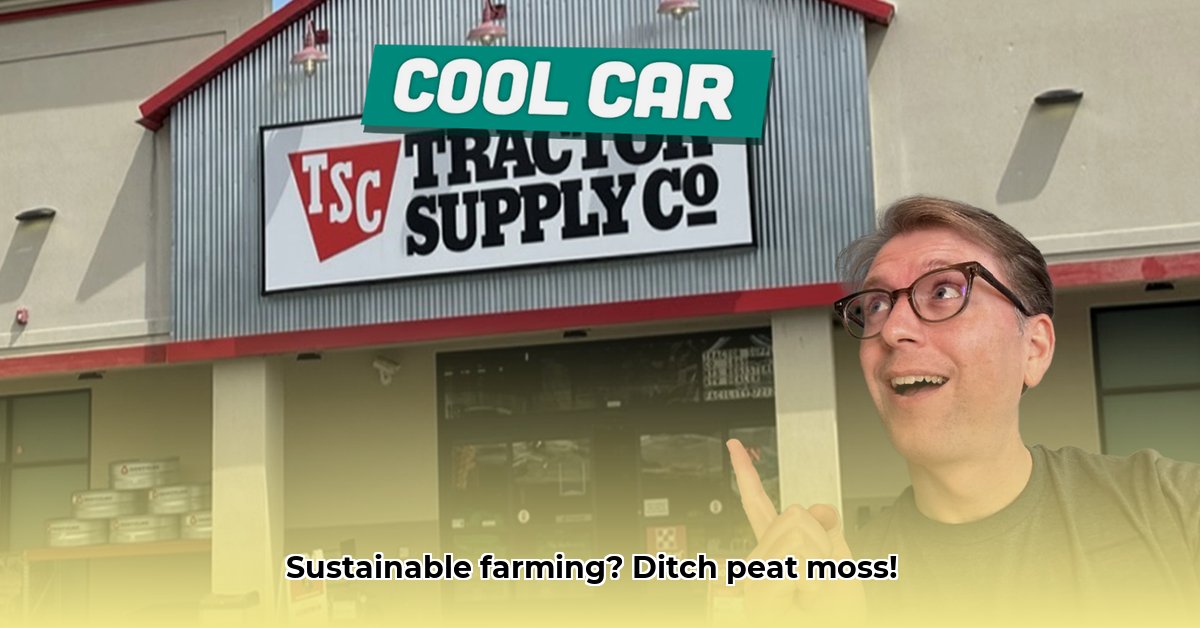
Peat Moss Tractor Supply Alternatives: A Greener Approach to Farming
For years, peat moss has been a staple in agriculture, prized for its water retention and aeration properties. However, its extraction carries a significant environmental cost. Harvesting peat moss damages vital wetlands, releasing substantial amounts of stored carbon dioxide—a major greenhouse gas—into the atmosphere, contributing to climate change. This raises a critical question: Is continued reliance on peat moss truly sustainable for the long-term health of our planet and the future of farming? The answer, increasingly supported by scientific consensus, is a resounding no. Fortunately, effective and environmentally friendly alternatives are readily available. For more options, check out farm fencing options.
The Environmental Footprint of Peat: A Bigger Picture
The environmental impact of peat harvesting extends beyond carbon emissions. Wetlands, the source of peat, play a crucial role in biodiversity, acting as habitats for countless plant and animal species. Their destruction leads to habitat loss and threatens the delicate balance of these ecosystems. Dr. Emily Carter, Soil Scientist at the University of California, Berkeley, emphasizes, "The unsustainable harvesting of peat moss is not just about carbon; it's about the irreversible loss of biodiversity and the disruption of vital hydrological cycles." Therefore, transitioning to sustainable alternatives is not merely an environmental preference but a necessity for responsible agricultural practices.
Sustainable Substitutes: A Growing Field of Choices
Fortunately, a range of eco-friendly peat moss alternatives offer comparable benefits without the detrimental environmental consequences. These alternatives are becoming increasingly accessible and cost-effective, making the transition to sustainable practices achievable for farmers of all scales.
Composted Bark: Nature's Soil Enhancer
Composted bark, a readily available and renewable resource, significantly improves soil structure, promoting excellent drainage while retaining adequate moisture. Its use minimizes environmental impact while offering comparable performance to peat moss. This readily available alternative represents a straightforward and impactful change for farmers seeking sustainable solutions.
Coconut Coir: A Tropical Alternative with Global Benefits
Derived from coconut husks, coconut coir provides exceptional drainage and water retention, making it a viable substitute for peat moss. Moreover, its use supports coconut farming communities, often in developing countries, generating economic opportunities while promoting environmental sustainability. This option provides a compelling combination of ecological and socio-economic benefits.
Recycled Materials: Giving Waste a New Life
Innovative companies are now producing effective soil amendments from recycled paper, wood, and other materials, diverting waste from landfills and reducing environmental impact. While ongoing research is evaluating the long-term effects of these materials on soil health, their potential as sustainable alternatives is promising, representing a significant advancement in circular economy principles within agriculture.
Choosing the Right Alternative: Factors to Consider
Selecting the optimal peat moss replacement depends on several factors, including cost-effectiveness, accessibility, and suitability for specific soil types.
- Cost: Prices vary significantly across different alternatives, demanding careful comparison on a per-unit basis to ensure long-term value.
- Accessibility: Prioritize locally sourced materials to minimize transportation costs and carbon emissions.
- Soil Type: Experimentation might be necessary to determine the most effective amendment for your soil conditions. Understanding your specific soil needs is crucial to successful implementation.
Making the Switch: A Gradual Transition
Transitioning to sustainable alternatives doesn't require an immediate overhaul. Begin by incorporating small amounts of chosen alternatives into your existing practices. Gradually increase usage as you assess performance and refine your approach. This phased approach allows for effective adaptation and risk mitigation, ensuring a smooth transition to environmentally responsible farming.
Comparing Peat Moss Alternatives: A Side-by-Side Look
The following table summarizes the advantages and disadvantages of various peat moss alternatives:
| Amendment | Advantages | Disadvantages |
|---|---|---|
| Peat Moss | Excellent water retention, excellent aeration | Unsustainable harvesting, significant carbon emissions |
| Composted Bark | Renewable, improves soil structure, readily available | Might decompose faster than peat moss |
| Coconut Coir | Good drainage and water retention, supports developing economies | Potentially more expensive, transportation impacts |
| Recycled Materials | Environmentally friendly, reduces landfill waste | Long-term soil effects still under investigation |
The Future of Sustainable Soil Management
Shifting away from peat moss signifies a broader commitment to environmentally responsible farming practices. Embracing sustainable alternatives is not just beneficial for the environment; it’s about securing the long-term health and viability of agriculture itself. By making informed choices, farmers contribute to a healthier planet while ensuring the future of food production. The transition represents a significant step towards a more sustainable and resilient agricultural sector.